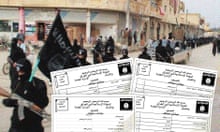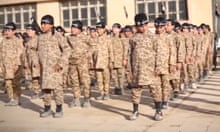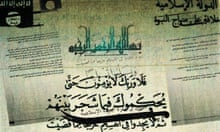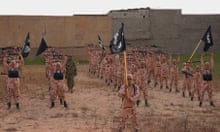British, US and German intelligence agencies are looking for potential leads in thousands of documents purporting to list Islamic State volunteers, while admitting that much of the information has been overtaken by events and that many of those named are dead.
Many of the 14 Britons whose details appear in the documents, copies of which were provided to the Guardian by the German newspaper Süddeutsche Zeitung, had already been identified publicly as fighting for Isis and most appear to have been killed.
The documents are questionnaires for would-be Isis recruits, listing their real names, their fake names, who introduced them, their countries, experience of jihad, education, date and place of birth, date of arrival in Syria, route, phone number and family.
Some analysts on Thursday cast doubt on the authenticity of the documents, pointing out mistakes and uncharacteristic language, although both British and German intelligence agencies indicated they had no reason to believe they were fake.
The Guardian managed to confirm that one of the mobile numbers contained in the documents, belonged to a relation of one of the British fighters, lending credibility to claims that the hoard is genuine. The number, which was listed on Portsmouth jihadi Asad Uzzaman’s form, was answered by a young women who confirmed his date of birth and that he was a family member.
The British jihadis named in the documents include Raphael Hostey, 23, from Manchester, Ifthekar Jaman, the cousin of Asad Uzzaman. Jaman, first came to the public’s attention when he gave an interview to BBC’s Newsnight in November 2013. He was killed in fighting the next month.
Many of the Britons named in the document have been confirmed as – or are believed to be – dead.
The fate of the Britons backs up what intelligence analysts have long been saying: that foreign recruits with no military experience are often thrown into the frontline or used as suicide bombers or given high-visibility propaganda roles that make them targets for drone strikes.
The three British intelligence agencies – MI5, MI6 and GCHQ – are still working their way through the cache to assess the value and significance of the hoard. Their initial focus is the British names, looking to see if there are fresh nuggets of information that can provide links to other jihadis or offer insights into the organisation’s structure.
A spokesperson for the German federal office for criminal investigations confirmed it was in possession of a dataset with details of individuals who had signed up for Isis. The spokesperson said investigators considered the data “highly likely to be authentic” and were currently using it in their research and counter-terrorism activities.
News of the documents was first broken by Süddeutsche Zeitung on Monday evening. The paper said it was offered documents several weeks ago by someone seeking a large payment in return. The paper declined and sent its own reporters to the region, in particular Iraqi Kurdistan, where it said dozens of similar documents were available from Kurdish fighters and Isis members.
The daily said it had the names of tens of thousands of jihadis.
Sky News on Wednesday expanded on the German paper’s story, saying it had tens of thousands of documents containing 22,000 names of Isis volunteers. Sky said they had been passed on by a former Free Syrian Army convert to Isis, calling himself Abu Hamed, who had become disillusioned. It said he had stolen the documents, held on a memory stick, from the head of Isis’s internal security police.
The questionnaires that seem to make up the bulk of the documents cache were filled out in November and December 2013. The eventual value of the documents may lie primarily in offering insights into the patterns of recruitment at the time, including which countries the volunteers were mainly drawn from. A drawback is that it is a snapshot from 2013 and recruitment patterns may have changed as Isis became better known in Europe in the following years.
The German federal office for criminal investigations would neither confirm nor deny that the dataset obtained by Sky was the same as the one in its possession, or the same one Süddeutsche Zeitung had. “Our investigations are ongoing,” the spokesperson said.
Syrian opposition news website Zaman al-Wasl said there were thousands of repetitions in the leaked documents and the names of only 1,700 people could be identified in the 22,000 documents.
One of the analysts who expressed scepticism about the documents was Aymenn al Tamimi, one of the world’s foremost experts on dealing with Isis. He told the Guardian: “At first I was quite impressed but as time has gone on I’ve had more doubts about the authenticity of these documents.”
He said he had worries about certain logos which he had not seen before in hundreds of other Isis documents he had handled. “Volume doesn’t prove authenticity,” he added.
The AFP news agency cited analysts pointing out what they said where mistakes or uncharacteristic. “There would be big alarm bells for me, because when I’ve seen inconsistencies like that in the past they’ve been on really shoddily made forgeries,” Charlie Winter, a researcher at Georgia State University, told AFP.
The Arabic name for “The Islamic State in Iraq and Syria”, Isis’s previous name, is written in two different ways, including one that is not consistent with past practice. Files documenting the deaths of Isis militants use the words “date of killing” instead of the typical jihadi term “martyrdom”.
Another analyst, Romain Caillet, also noted that some documents featured a second, circular logo not previously used on Isis files.
Journalist and jihadism analyst Wassim Nasr said the inconsistencies called into question the authenticity of at least some of the documents.
“Maybe some of the information is real, while the layout was fabricated to sell the information at a high price to different buyers,” Nasr posted on Twitter.









